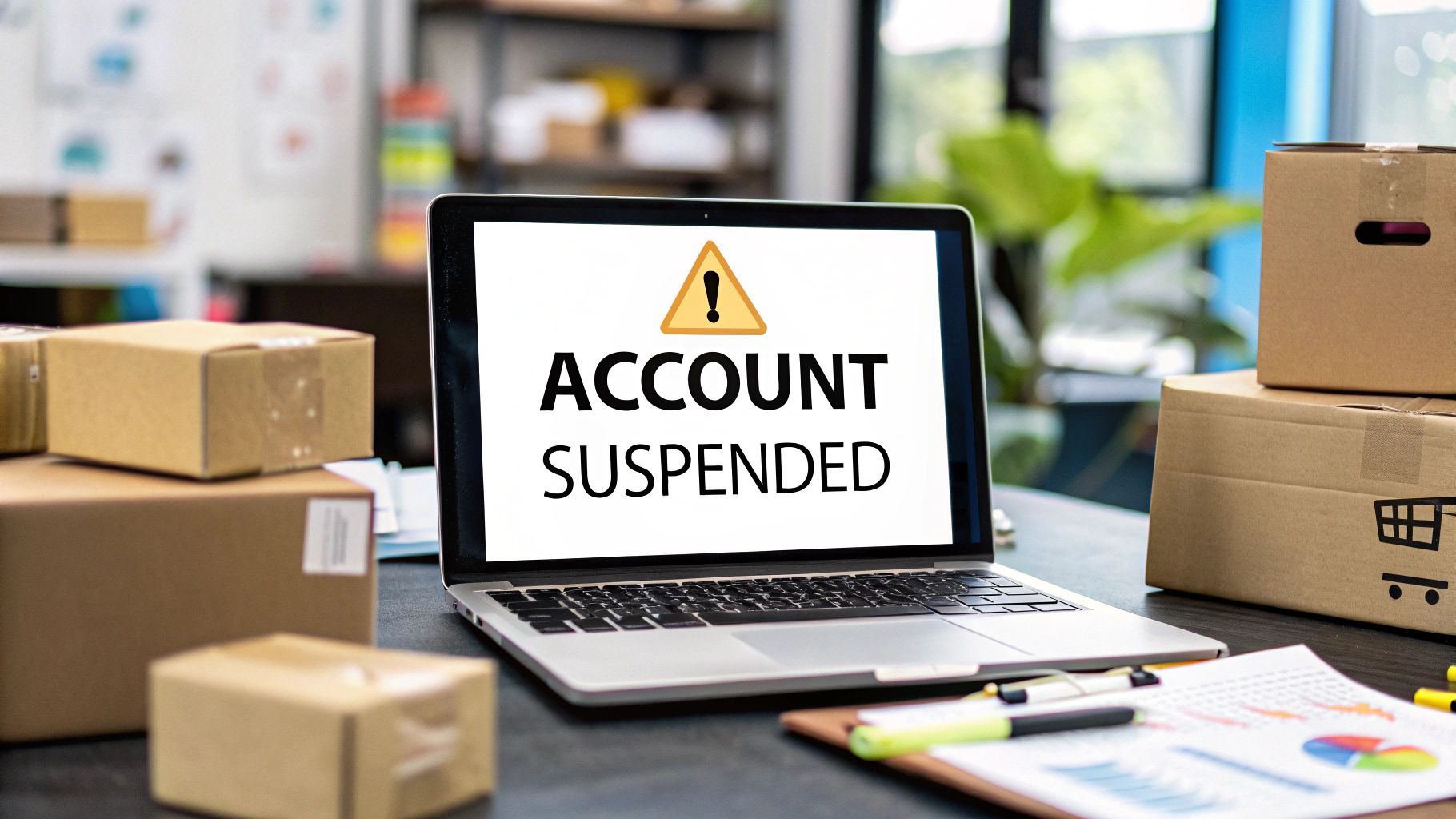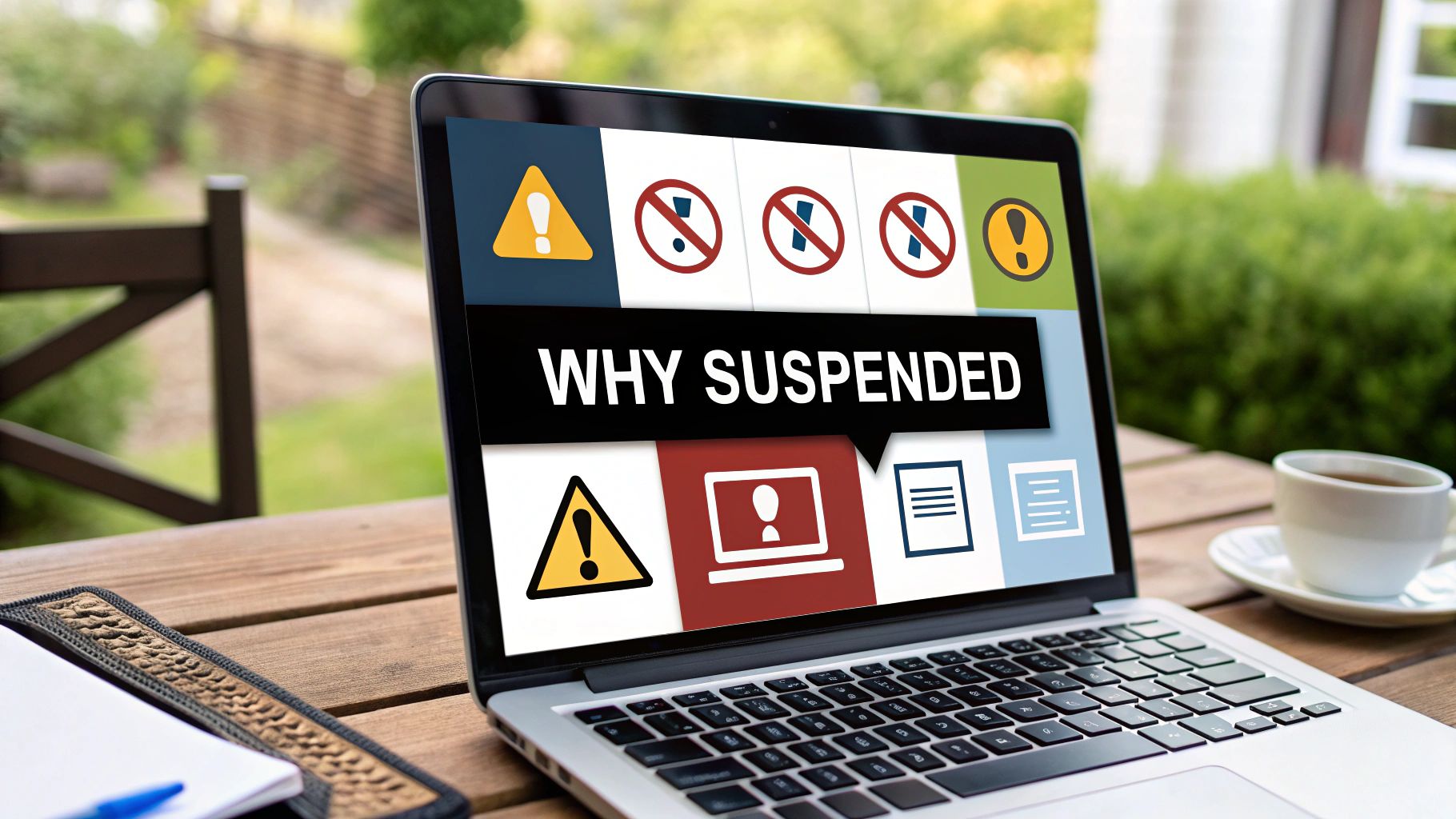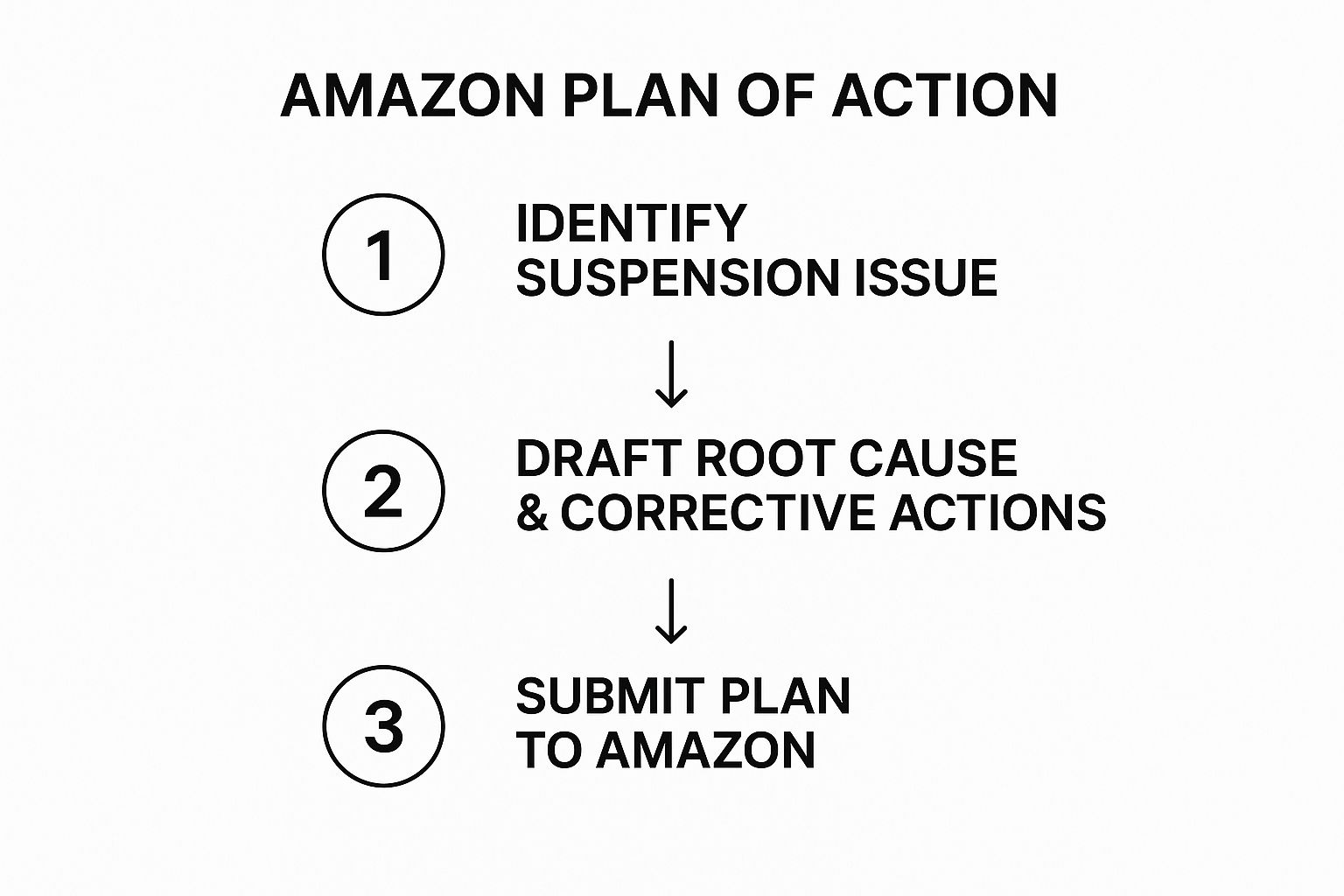Stay Updated with Everything about MDS
Thank you! Your submission has been received!
Oops! Something went wrong while submitting the form.

Chilat Doina
August 20, 2025
There’s nothing quite like the gut-punch of receiving an Amazon account suspension notice. It feels like your entire business just slammed into a brick wall. Sales stop dead in their tracks, and your funds are instantly frozen.
What this notice really means is that your selling privileges have been put on pause because of a policy violation or a performance issue. But here's the key: a suspension isn't a permanent ban. It's a critical, time-sensitive problem that requires a cool head and a strategic response to get back online.

That notification email from Amazon lands, and your first instinct is probably to fire off a frantic, emotional reply. Don’t. That’s the single biggest mistake you can make.
The first, most important step is to just stop. Take a breath and look at the situation without panicking. A rushed, poorly thought-out appeal will almost certainly get rejected, digging you into an even deeper hole.
To get back in control, you need to figure out exactly what kind of action Amazon has taken against your account. Not all deactivations are the same, and knowing the difference is everything when it comes to crafting a winning response.
It helps to think of Amazon's actions like a traffic light. Each color represents a different level of severity and tells you what to do next. It's a simple way to bring some clarity to a seriously stressful situation.
Your number one goal after a suspension is to shift out of panic mode and into planning mode. Getting reinstated starts with a solid diagnosis of the problem, not a knee-jerk reaction.
Understanding exactly where you stand is the foundation for a successful recovery. A suspension is a serious problem, but it's a manageable one. By correctly identifying the action taken against you and fighting the urge to reply instantly, you can start building a logical, fact-based appeal that has a real shot. This is how you build the framework and confidence to tackle the problem head-on and get your account back online.

So you got the dreaded email from Amazon. The first thing you need to do is figure out why. That notification email can feel frustratingly vague, leaving you scrambling to connect the dots. But suspensions rarely come out of thin air. They're almost always triggered by something specific, whether it's your performance, a policy slip-up, or even an account you forgot you had.
Think of it this way: your seller account just failed a rigorous inspection. The whole car is now off the road, and it's your job to find the faulty part before you can even think about getting back in business.
Jumping into an appeal without a solid diagnosis is like telling a mechanic "the car's broken" and expecting a fix. It’s a guaranteed recipe for rejection. You have to pinpoint the exact problem first.
Amazon is utterly obsessed with customer experience, and your Seller Central dashboard is their scorecard. The platform is constantly tracking key performance indicators (KPIs) to make sure you're keeping shoppers happy. When those numbers start to slide below their strict targets, automated systems flag your account, and a suspension often follows.
The big one here is your Order Defect Rate (ODR). Amazon demands that sellers keep their ODR under 1%. This single metric is a powerful snapshot of your overall health and is made up of three key components:
If your ODR inches over that 1% line, you’re officially in the danger zone. It's a massive red flag to Amazon that your customers are having serious issues, making a suspension almost inevitable.
A high Order Defect Rate is a clear signal to Amazon that something is fundamentally broken in your fulfillment or customer service process. Ignoring it is the fastest way to an account deactivation.
If performance metrics are about maintaining standards, policy violations are about breaking the non-negotiable rules. Amazon sees these as far more serious offenses because they can destroy customer trust or even get the company in legal trouble. A single, major violation can get you shut down instantly, even if your metrics are otherwise perfect.
These violations come in all shapes and sizes, but a few are surefire account killers:
Amazon's bots are constantly crawling listings for these kinds of violations. They’re good, but not perfect, and sometimes they flag legitimate sellers by mistake. That’s why it’s critical to investigate the claim and arm yourself with evidence before you start writing your appeal.
One of the sneakiest and most frustrating reasons for a suspension is the dreaded linked account issue. This one catches tons of sellers off guard because the problem has nothing to do with what you're selling or how you're performing today. Instead, it comes from a connection Amazon's algorithm has made to another, separate seller account.
Amazon's policy is crystal clear: you cannot operate more than one Seller Central account without a legitimate business reason and their explicit, prior approval. The platform's detection systems have become incredibly sophisticated at sniffing out these connections. They can link accounts through shared IP addresses, bank accounts, physical addresses, names, or any data point tied to a previously suspended account.
If one of those connected accounts goes down, Amazon often deactivates all related accounts as a precaution. This policy exists to stop bad actors from just opening a new shop after getting banned. Unfortunately, it can also trap innocent sellers who have an old, dormant account they forgot about or unknowingly share information with another seller. The key is to dig deep, find any possible connection—no matter how small—and address it head-on in your Plan of Action.

Most sellers think of customer feedback as just a bunch of star ratings and product reviews. But in reality, it's one of the fastest ways to get your Amazon account suspended. Amazon isn't just glancing at this feedback; its algorithms are crunching every single data point to build a detailed picture of the experience you're providing.
Think of your seller account as a ship. Bad performance metrics are like a slow leak, manageable if you stay on top of it. Consistently negative customer feedback, on the other hand, is a sudden storm that can sink you without much warning.
This is where the Voice of the Customer (VoC) dashboard becomes your best friend or your worst enemy. It’s not just another page in Seller Central—it’s Amazon’s internal early warning system. The VoC pulls in everything from return reasons and A-to-z claims to reviews and customer service chats, then boils it all down to a simple health rating for each of your products.
Your VoC dashboard is basically a health report card for every ASIN you sell. It scores your products from "Excellent" all the way down to "Very Poor." The second a product slips into the "Poor" or "Very Poor" category, a massive red flag goes up for Amazon's bots.
These low ratings are almost always caused by specific, recurring problems. Maybe the product is faulty, or maybe your listing is setting the wrong expectations. For instance, if you see a wave of returns citing "not as described," Amazon knows your product detail page is misleading people.
Some of the most common triggers for a bad VoC rating include:
When these issues start stacking up against one of your products, Amazon's first move is usually to suppress the ASIN. Your listing becomes inactive, but your account is still safe. For now. But if you ignore that warning or if other products start following the same downward trend, things escalate quickly.
An ASIN suppression is a direct warning shot from Amazon. Ignoring it or failing to address the underlying customer issue is a direct path to a full account suspension.
The leap from a suppressed listing to a suspended account happens much faster than sellers anticipate. From Amazon’s perspective, a pattern of poor VoC ratings across your catalog is hard proof that you can’t maintain the quality standards their customers expect.
To stay off their radar, you have to treat your VoC dashboard as your primary intelligence tool. It’s the best place to spot and fix problems before they blow up. Make it a habit to check your dashboard, find your underperforming ASINs, and actually read the customer comments to pinpoint the root cause.
Knowing how to manage these interactions is crucial. For a deeper dive, you can explore strategies for effectively gathering customer feedback that won't waste your time. By using the VoC dashboard to listen to what your customers are really saying, you can fix product flaws, correct inaccurate listings, and tighten up your operations—keeping both your buyers and Amazon’s bots happy.
When your Amazon account gets suspended, the Plan of Action (POA) you submit is everything. This isn't just an email or a chance to vent your frustrations. Think of it as a formal business document—your one shot to convince a team of investigators that you get it. You understand the mistake, you’ve already fixed it, and you've built a system to make sure it never, ever happens again.
A flimsy, defensive, or vague POA is the fastest way to get your appeal rejected. I’ve seen it happen time and time again. To get back online, your response needs to be structured, packed with facts, and show that you’ve taken complete ownership of the problem. A successful POA is built on three core pillars that give Amazon’s performance team exactly what they’re looking for.
This flow chart breaks down the high-level steps you'll take, from getting the suspension notice to submitting your appeal.

It’s a simple roadmap: figure out what went wrong, create a bulletproof plan, and then submit it for review.
Before you can fix anything, you have to prove you understand what truly broke. This is the heart and soul of your POA. Amazon’s team needs to see you’ve done more than just glance at their suspension email. They need proof you’ve conducted a real-deal internal investigation to find the fundamental breakdown in your operations.
Just saying "we got customer complaints" is a symptom, not a root cause. You have to dig deeper.
See the difference? The second one is powerful. It names the specific process failure, the exact ASIN, and the precise impact. It screams "I've done my homework."
Okay, you’ve pinpointed the problem. Now, what have you done to clean up the mess? This section is all about the "now." It’s where you show Amazon you’ve already handled every single issue related to the suspension.
The key here is to use the past tense. This isn't about what you plan to do; it’s about what you have already done.
Here's what you should list:
Your corrective actions need to be specific and concrete. A vague promise like "we improved customer service" is useless. Instead, write something like, "We have assigned a dedicated team member to respond to all customer inquiries within 8 hours, a significant improvement from our previous 24-hour response time."
This final piece is arguably the most important. This is where you prove to Amazon that this specific issue will never darken their doorstep again. You’re looking forward now, focusing on the new systems, processes, and guardrails you’ve put in place. This is how you rebuild trust.
Your preventative measures have to directly tackle the root cause you identified in Pillar 1. If the problem was shoddy quality control, your solution must be a new, ironclad quality control system.
Examples of effective preventative measures:
To help you put it all together, here’s a quick guide on what to do—and what to absolutely avoid—when writing your POA.
Following this structure isn't just about checking boxes. It’s about building a logical, compelling case for your reinstatement. When you clearly outline the root cause, the immediate fixes, and the long-term prevention, you answer all of the investigator's questions before they even have to ask. That makes it incredibly easy for them to click "approve" and get your business back up and running.
You’ve survived the reinstatement process and your selling privileges are back. That’s a huge relief, but the fight isn’t over. Honestly, it’s only half the battle.
The real victory isn't just clawing your way back from a suspension. It's building an operation so solid, so buttoned-up, that you never have to go through that nightmare again. This means flipping a switch in your brain—moving from constantly putting out fires to making sure they never start in the first place.
Protecting your account isn't about a one-time fix. It’s a daily commitment, weaving smart habits into the very DNA of your business. Think of it like owning a high-performance car. You don't just wait for it to break down on the side of the highway. You do the regular oil changes, check the tires, and listen for any weird noises. That’s what keeps it running smoothly.
The sellers who thrive on Amazon for the long haul are the disciplined ones. They aren’t waiting for a policy warning to pop up. They’re actively hunting for potential problems inside their own business, heading them off at the pass.
This is where regular internal audits come in. It’s the cornerstone of a proactive strategy.
Set a schedule—maybe monthly, maybe quarterly—and stick to it. This isn't just a quick peek at your dashboard. It's a full-on deep dive to catch any red flags before Amazon does.
A solid audit should hit these key areas:
Your Account Health Dashboard is basically mission control. Ignoring it is like driving with the check engine light on—you might get away with it for a while, but eventually, you're going to break down.
Make checking this dashboard part of your daily routine. No excuses.
Don’t just glance at the overall green-yellow-red rating. Dig into the details. Keep a close eye on your Order Defect Rate (ODR), Late Shipment Rate, and any policy compliance warnings. A single unresolved warning can sit there like a time bomb, waiting for another small issue to pop up and trigger a full suspension.
Just as important is the Voice of the Customer (VoC) dashboard. This is a direct pipeline into what your customers are thinking. If you see a rising Negative Customer Experience (NCX) rate for a product, that's Amazon firing a warning shot. By watching this data, you can fix product defects or confusing listing details long before the bots step in.
Proactive account management means treating every warning and every dip in your metrics like a five-alarm fire. The best sellers don't wait for the flames; they investigate the first whiff of smoke.
Amazon's rulebook is written in pencil, not stone. It’s constantly changing. What was perfectly fine last quarter might be a major policy violation today. You absolutely have to subscribe to Amazon's seller newsletters and check the Seller Central news feed regularly.
This has never been more important. In recent years, suspensions have skyrocketed as Amazon has cracked down with stricter—and often automated—enforcement. It's a tough environment out there, and staying on top of policy is your best defense. If you want to understand just how intense things have gotten, you can learn more about the rise in Amazon seller suspensions.
At the end of the day, preventing an Amazon account suspension comes down to operational excellence. When you consistently audit your business, obsess over your health metrics, and manage your inventory intelligently, you’re building a fortress. This not only shields you from suspension but also paves the way for serious growth. For more on that, check out our guide on proven strategies to increase your Amazon sales.
Getting hit with an Amazon account suspension can feel like you've been dropped into a maze with the lights off. Even with a solid Plan of Action in hand, you're going to have questions—urgent, specific ones—popping into your head.
This section cuts right to the chase, giving you straight answers to the most common things sellers worry about during this incredibly stressful time. My aim is to arm you with the clear, concise info you need to handle your conversations with Amazon's performance and support teams.
This is the million-dollar question, and the honest answer is: it's almost entirely up to you.
The clock really starts ticking the second you submit your Plan of Action (POA). Once you hit send, you can generally expect to hear something back from Amazon within two to three days, but don't hold your breath—that’s just an estimate, not a promise.
If they accept your appeal, you could be back online almost instantly. But if they deny it, the suspension continues, and you're back to square one, rewriting your POA and resetting the timeline. The whole ordeal can take anywhere from a few days to several agonizing weeks, all depending on how complicated your issue is and how well you write your appeals.
In a word: no. Don't even think about it.
Trying to sneak around a suspension by opening a new account is one of the biggest mistakes you can possibly make. It's a direct violation of Amazon's policy against operating multiple seller accounts without getting their explicit, written permission first.
Amazon’s systems are shockingly good at sniffing out linked accounts. They cross-reference everything: bank details, IP addresses, names, physical locations. If you open a new account, they will find it, link it to your suspended one, and shut it down immediately. This just digs your hole deeper, making it that much harder to ever get your original account back.
Your only real path forward is to face the music, fix the problems with your current account, and get it reinstated the right way.
When your account gets suspended, your FBA inventory is essentially put on ice. It stays right where it is in Amazon's warehouses, but your listings go dark. You can't sell a thing.
You've got a couple of choices here:
Most sellers choose to leave their inventory right where it is for the first 30 days while they pour all their energy into the reinstatement process. If things drag on longer than that, you might have to bite the bullet and create a removal order to stop the storage fees from bleeding you dry. Successfully managing these kinds of tough decisions is a huge part of what it takes to improve your Amazon sales and dominate the marketplace for the long haul.
It seems like the logical first step, but contacting the regular Seller Support team is usually a waste of time. They just don't handle suspension appeals.
The standard support reps have zero power to reverse a suspension. At best, they can only read you the same generic information you already have.
The only team that can help you is the Seller Performance team, and they work almost exclusively through the appeal process in your Account Health Dashboard. Blowing up Seller Support with calls and cases won't get your review done any faster. In fact, it just creates noise that can slow things down. Your best bet is to focus every ounce of your energy on writing a perfect Plan of Action and submitting it to the right people.
At Million Dollar Sellers, we get the high-stakes world of e-commerce because we live in it. Our exclusive community is built for top-tier entrepreneurs who want to scale their businesses by sharing proven strategies and learning from the best in the industry. If you’re a serious seller looking to connect with a powerful network of 7, 8, and 9-figure founders, find out if you qualify to join us.
Join the Ecom Entrepreneur Community for Vetted 7-9 Figure Ecommerce Founders
Learn MoreYou may also like:
Learn more about our special events!
Check Events